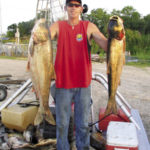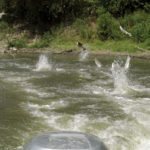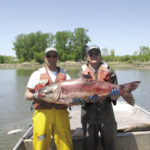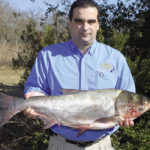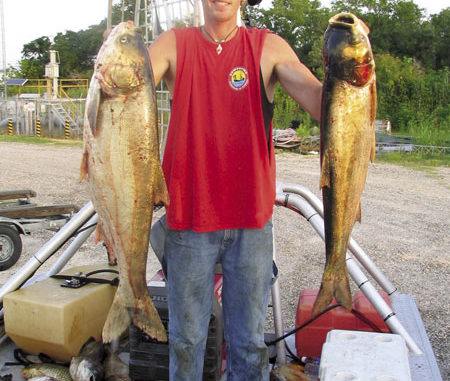
Catching these fish is easy — they literally jump in the boat, and when they do, it’s like manna from heaven.
I first met Hypophthalmichthyes molitrix on a warm summer’s night in 1997. A scimitar-shaped crescent moon hung over the humid night’s air in the Atchafalaya Basin.
One of my best friends, the late Sandy Corkern, and I were on a frogging mission in Lake Chicot oilfield in the heart of the Basin. I was at the tiller handle, and he was in the bow doing the grabbing.
Spying the glowing orbs of a huge frog, I turned the boat sharply to the left. Immediately, a silver missile almost 2 feet long arced into the boat, violently ricocheted off the gunnels six or seven times and jumped back overboard. I knew it was a fish, but it happened so quickly that I couldn’t identify what kind it was.
“What was that?” asked Corkern after he turned to face me.
“I don’t know,” I replied, “but it looked like a silver bullet.”
A half-hour later, another one jumped in the boat, but this one hit me square on my right temple, dazing me and knocking stars into my eyes. After my vision returned, I saw a slab-sided bright silver fish, weighing about 5 pounds, lying on the bottom of the boat in front of me. Apparently, my head was harder than the aluminum boat’s gunnels, because this one wasn’t moving a muscle.
By the light of day the next morning, I inspected the creature. From the gills back, it closely resembled in shape and scale structure a salmon. But the head could only be described as “stupid-looking.”
The eyes of the fish were on the lower half of the head instead of on the upper half like for every other respectable fish. The peculiar placement of the fish’s eyes is reflected in its tongue-twisting scientific name, Hypophthalmichthys, which is Greek for “below-eye fish.”
A check of my fish references back at the office the next day confirmed that I had a silver carp. I knew that silver carp were on the loose in Louisiana. Reports had come in a year ago that at times boat travel on the Boeuf River, north of Jonesville, was becoming hazardous because of leaping silver carp.
Since then, silver carp have invaded virtually every bit of freshwater habitat in the state, including coastal freshwater marshes. Equal numbers of bighead carp, Hypophthalmichthys nobilis, and a few black carp, Mylopharyngodon piceus, can also be found in Louisiana waters. Bighead carp, which resemble silver carp except for having a blotchy body color, are a much calmer fish and not prone to jumping when disturbed by outboard-motor noise.
Freshwater commercial fishermen are hauling up hoop nets often holding hundreds of pounds of silver and bighead carp in every major river. Recreational boaters and fisherman can hardly escape the fish, some of them up to 50 pounds in weight, jumping into their boats, especially at night. The fish are firmly established in the state, and eradication appears impossible.
So, what do you do?
Louisiana Department of Wildlife and Fisheries (LDWF) biologists have teamed up with private interests to promote the consumption of the fish. If you can’t beat them — you eat them.
In January the department, in cooperation with French Chef Philippe Parola, Chef Cullen Lord of Flemming’s Restaurant and Darryl Rivere, owner of A la Carte Foods, put on an impressive bash at LDWF headquarters in Baton Rouge in unveiling their promotion of silver and bighead carp as food fish.
The fish are unofficially called silverfin; LDWF is seeking a formal name change.
Parola and associates served quantities of fried silverfin wings, fried silverfin cakes, fried silverfin-sweet potato kickers, silverfin gumbo, silverfin spread and silverfin jerky.
All were good. In fact, all were great.
I went to the event with a jaundiced opinion. Growing up as a country boy, I ate quite a few common carp. The meat of these fish is dark, musty, muddy and laced with infinitesimally tiny bones that are free-floating throughout the flesh.
During the build-up to the event, Parola described the fish’s flesh as tasting somewhere between crabmeat and scallops. Surprisingly, it did have a shellfish taste. And it was flakey and white to boot. I gave it an A+.
The promotion is two-pronged. One effort is to develop a commercial seafood market for these abundant fish. Market development is focused on promoting the sale of processed silverfin products, since the fish is boney and producing a finished product takes some work.
The second approach is to encourage recreational fishermen to use the fish that jump in their boats, or better yet come up with ways to catch them deliberately. Because most of the diet of the two species consists of microscopic plants and animals, anglers are unlikely to catch many with traditional fishing equipment.
Some fishermen have become innovative. One, located on Tunica Lake in extreme northwestern Mississippi, has rigged a net resembling a baseball back stop up on his party barge. Every nighttime trip yields hundreds of pounds of silver carp.
LDWF has made every effort to change rules to make it easy to take these abundant fish. It has no size limits, nor does it have any creel or possession limits. The use of bows and arrows is legal, as is snagging, spearing and dip netting. Even the use of boats as fishing equipment has been legalized.
Gary Tilyou, administrator of the LDWF’s Inland Fisheries Division recommends bleeding each fish immediately after it is caught by cutting off the tail. This improves the color and quality of the meat, but also helps meet the department’s requirement that only dead Asian carp may be transported. This rule is in place to prevent them from being stocked into waters where they do not already exist.
